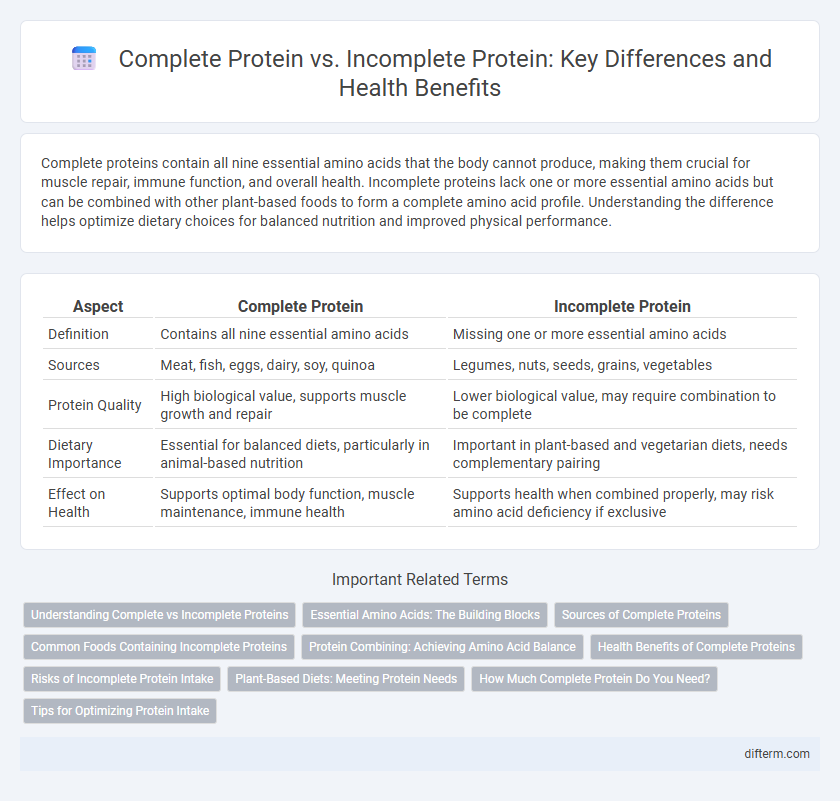Complete proteins contain all nine essential amino acids that the body cannot produce, making them crucial for muscle repair, immune function, and overall health. Incomplete proteins lack one or more essential amino acids but can be combined with other plant-based foods to form a complete amino acid profile. Understanding the difference helps optimize dietary choices for balanced nutrition and improved physical performance.
Table of Comparison
| Aspect | Complete Protein | Incomplete Protein |
|---|---|---|
| Definition | Contains all nine essential amino acids | Missing one or more essential amino acids |
| Sources | Meat, fish, eggs, dairy, soy, quinoa | Legumes, nuts, seeds, grains, vegetables |
| Protein Quality | High biological value, supports muscle growth and repair | Lower biological value, may require combination to be complete |
| Dietary Importance | Essential for balanced diets, particularly in animal-based nutrition | Important in plant-based and vegetarian diets, needs complementary pairing |
| Effect on Health | Supports optimal body function, muscle maintenance, immune health | Supports health when combined properly, may risk amino acid deficiency if exclusive |
Understanding Complete vs Incomplete Proteins
Complete proteins contain all nine essential amino acids required by the human body for muscle repair, immune function, and overall health. Incomplete proteins lack one or more essential amino acids, making it necessary to combine different plant-based sources like legumes, grains, and nuts to achieve a balanced amino acid profile. Understanding the distinction supports informed dietary choices, especially for vegetarians and vegans aiming to meet their protein needs efficiently.
Essential Amino Acids: The Building Blocks
Complete proteins contain all nine essential amino acids necessary for human health, making them vital for muscle repair, enzyme production, and overall bodily functions. Incomplete proteins lack one or more essential amino acids, requiring dietary combinations to ensure the body receives all building blocks for protein synthesis. Foods such as meat, dairy, and quinoa provide complete proteins, while many plant-based sources like beans and grains need to be paired to meet essential amino acid requirements.
Sources of Complete Proteins
Complete proteins contain all nine essential amino acids necessary for human nutrition and are primarily found in animal-based sources such as eggs, dairy, meat, poultry, and fish. Plant-based complete protein sources include quinoa, soy products like tofu and tempeh, and buckwheat, providing essential amino acids for vegetarian and vegan diets. Combining incomplete protein sources like legumes and grains can also create a complete amino acid profile, but direct sources of complete proteins simplify meeting dietary requirements.
Common Foods Containing Incomplete Proteins
Common foods containing incomplete proteins include grains like rice, wheat, and corn, as well as legumes such as beans, lentils, and peas. These plant-based sources lack one or more essential amino acids, making them incomplete protein providers. Combining different incomplete protein foods, like rice and beans, can create a complete amino acid profile necessary for optimal health and muscle repair.
Protein Combining: Achieving Amino Acid Balance
Complete proteins contain all nine essential amino acids in adequate amounts, found primarily in animal-based sources like meat, eggs, and dairy. Incomplete proteins, typically plant-based such as beans, grains, and nuts, lack one or more essential amino acids but can be combined through protein combining to achieve a balanced amino acid profile. Pairing complementary incomplete proteins, like rice and beans or peanut butter on whole wheat bread, ensures the body receives a full spectrum of essential amino acids necessary for muscle repair, enzyme production, and overall health.
Health Benefits of Complete Proteins
Complete proteins contain all nine essential amino acids necessary for muscle repair, immune function, and overall cellular health. Consuming complete proteins from sources like eggs, lean meats, and quinoa supports optimal body function and promotes faster recovery from illness or injury. These proteins improve nutrient absorption and aid in maintaining muscle mass and metabolic health, reducing risks of chronic diseases.
Risks of Incomplete Protein Intake
Incomplete protein intake can lead to deficiencies in essential amino acids required for muscle repair, immune function, and hormone synthesis. Prolonged consumption of incomplete proteins without proper combination increases the risk of malnutrition, weakened immune response, and impaired cognitive function. Individuals relying heavily on plant-based diets must ensure diverse protein sources to mitigate these health risks.
Plant-Based Diets: Meeting Protein Needs
Complete proteins contain all nine essential amino acids, which are critical for muscle repair and overall health, typically found in animal products but also in some plant sources like quinoa and soy. Incomplete proteins, common in most plant foods such as beans, rice, and nuts, lack one or more essential amino acids, making it necessary to combine different plant foods to achieve a complete amino acid profile. Plant-based diets can effectively meet protein needs by strategically pairing complementary proteins, such as legumes with grains, to ensure adequate intake of all essential amino acids for optimal nutrition.
How Much Complete Protein Do You Need?
Adults generally require about 0.8 grams of complete protein per kilogram of body weight daily to support muscle repair and overall health. Complete proteins contain all nine essential amino acids in adequate amounts, making them crucial for meeting dietary needs efficiently. Consuming a balanced mix of complete and complementary incomplete proteins can ensure sufficient intake without over-reliance on a single food source.
Tips for Optimizing Protein Intake
Optimize protein intake by combining incomplete protein sources like beans and rice to create a complete amino acid profile. Prioritize nutrient-dense options such as lean meats, dairy, eggs, and quinoa, which provide all essential amino acids. Monitor daily protein needs based on body weight and activity level to support muscle synthesis and overall health.
Complete Protein vs Incomplete Protein Infographic

 difterm.com
difterm.com